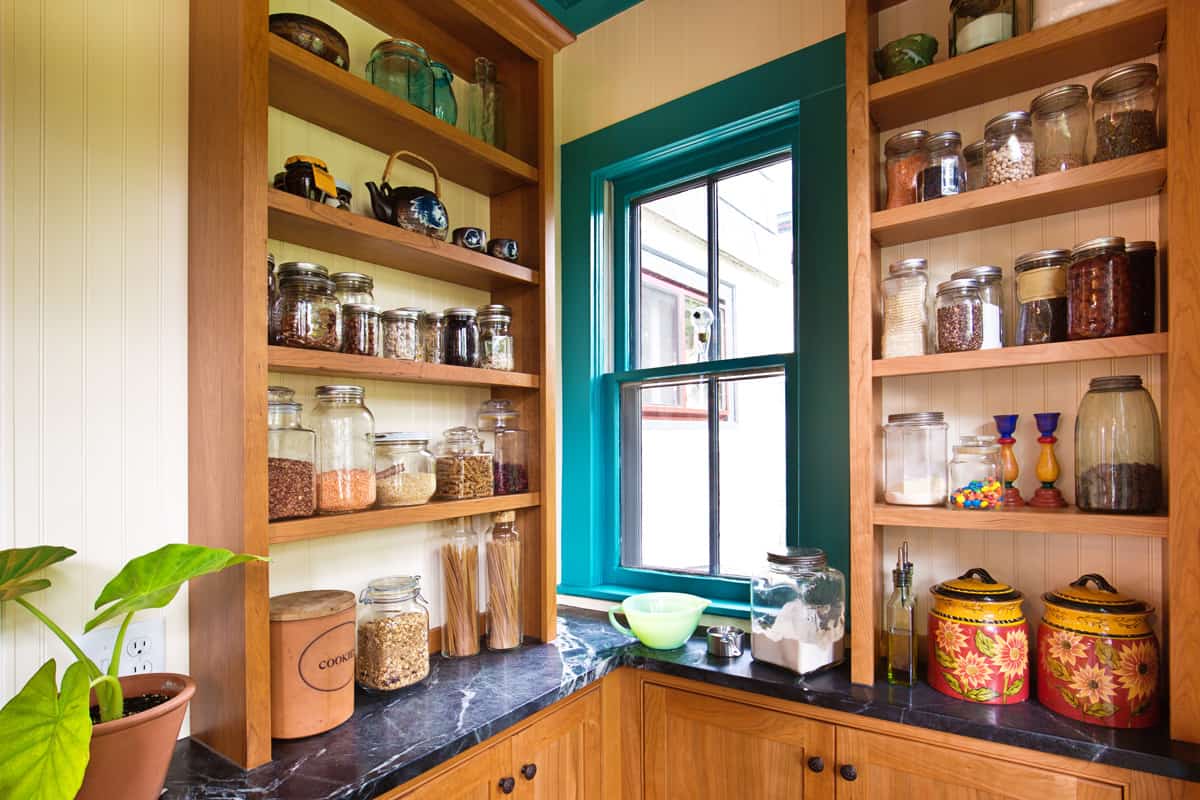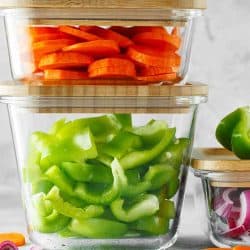If you live in a hot, humid climate or have noticed rusty cans among your non-perishable items, you’ve probably wondered if you need ventilation for your pantry. Proper ventilation and temperature can make all the difference in the freshness and safety of your pantry items. We researched this topic to get all the details you need to decide if adding ventilation to your pantry is necessary.
It is a good idea to think about ventilating your pantry for peace of mind. Ventilation regulates the temperature, protects against moisture build-up, prevents mold, and maximizes the longevity of your non-perishable foods. You may need to look into proper ventilation for your pantry if:
- You have trouble keeping your pantry within the proper temperature range.
- Any amount of moisture builds up in your pantry, causing cans to rust.
- You notice mold/mildew visually or by smell.
![A pantry with organized jars with a window for ventilation, Does a Pantry Need Ventilation? [3 Times When the Answer is yes]](https://kitchenseer.com/wp-content/uploads/2020/07/Does-a-Pantry-Need-Ventilation-3-Times-When-the-Answer-is-yes.jpg)
Before you panic and rush to add ventilation to your pantry, read on to see if it is the right option for your space. If your pantry meets specific standards, as is, year-round, you may not need to worry about this particular addition. However, if you’re worried about any of the three issues listed above, it’s best to get ahead of those problems and go ahead and ventilate your pantry.
Trouble Keeping Your Pantry the Right Temperature
First, assess your space and note a few essential conditions. Is one of your pantry’s walls also an outside wall? This could mean that any food you store on a shelf adjacent to this wall perishes more quickly or rises to higher temperatures at certain times of the year. If you live in a hot climate, this may be especially true.
One way to test to see if this is an issue is to hang a thermometer on that wall. Test the temperature daily to see if it ever rises above safe levels. If it does, you may need to add a vent in your pantry to ensure your food stays cool.
The ThermoPro digital thermometer is a popular choice. You can place it on one of your pantry's shelves, or hang it on the wall.
Click here to view this thermometer on Amazon
For a more classic look, you can try this gorgeous stainless steele non-digital thermometer by Miksus -
Click to see this thermometer on Amazon
Is the door to your pantry solid, or does it have slats? If the door is solid, hang a thermometer inside the pantry. Check it every day for a week to see if it ever rises higher than the overall temperature of your home. If the temperature increases to concerning levels, consider replacing your solid door for a slatted door for more air-flow in and out of your pantry.
Moisture Accumulating in Your Pantry Causing Cans to Rust
Rust is a serious sign that your canned food items are not safe to eat. According to the United States Department of Agriculture, rusted cans almost always mean that the iron has oxidized, which makes the food inedible. It’s best to throw away any containers that have accumulated rust to avoid food-borne illnesses.
How can we avoid rust in the first place? Keep condensation out of the pantry. Even the smallest amount of moisture damages food containers and reduces the shelf-life of non-perishable items.
One way to protect food from condensation is to store them in air-tight containers made of solid materials like glass or durable plastic. Even with the proper storage containers, moisture creates a big problem for a food’s shelf-life and edibility. When you open a container, the FDA explains that bacteria and other harmful substances can quickly spread to the inner contents.
The best way to cut down on moisture is to ventilate your pantry. When air flows freely, it helps to dry any excess condensation and prevents harmful build-up that could lead to a dreaded mold problem.
When You Notice Mold or Mildew in Your Pantry

The most significant and, perhaps, the most dangerous sign that you need ventilation is if you notice mold in your pantry. There are many resources out there to explain how to get rid of an existing mold problem, but the best way to avoid this problem in the first place is by maintaining proper ventilation.
WikiHow shares some useful tips on how to prevent mold in the kitchen, but it doesn’t give specifics for the pantry. Still, the advice they provide can be applied to any space in your home where moisture levels may rise. Make sure you allow air circulation in and out of your pantry to keep it dry and cool. If ventilation for your pantry seems like an expensive solution for your moisture problem, consider purchasing a small dehumidifier to use during humid months of the year.
Does This Apply to Me?
Evaluate your pantry space, your year-round climate, and humidity levels. If you live in a location with colder weather with low humidity, you may not need to worry about ventilation. Just make sure you check the temperature of your pantry, check for moisture accumulation, and watch for mold. It may surprise you to learn that even in a colder climate, your pantry can reach higher temperatures than you prefer, in which case it would be better to add ventilation.
What Temperature Should a Pantry Be?
The University of Georgia advises keeping your pantry between 50-70 ℉ to maintain the optimal freshness of your non-perishable items. They warn that heat may contribute to the loss of nutrients in your foods, so it’s best to keep your pantry cool at all times.
If you are unable to keep your pantry that cool, according to the USDA, it’s important not to let levels rise above 85 ℉ to avoid spoilage and potential food-borne illnesses.
How Do I Keep My Pantry Cool?
As stated previously, adding ventilation is the best way to keep your pantry cool. Other than ventilation, you may consider using the vent hood while cooking, storing items as far away from appliances (especially the stove) as possible, and opening windows in your kitchen or other adjoining rooms when the weather permits.
Keeping overhead fans on in adjoining rooms could help, and you may also consider purchasing a portable fan to place in your pantry during warmer months.
Should a Pantry Be Dark?
In short, yes! A pantry should stay dark in-between moments of searching for food items and ingredients.
According to Healthfully, “photodegradation” is a process in which light mixes with compounds in a food item and reduces its nutrient content, even artificial light! Not only will foods lose nutrients when exposed to light, but they may also lose flavor, color, and antioxidants.
The Verdict on Ventilation for Your Pantry
Ventilation is one fundamental way of maintaining a dry, cool, mold-free environment for your pantry items. If you desire fresh spices, dry pasta, and baking ingredients, make sure to keep them in air-tight containers in the dark. Keep your canned goods rust-free and your surfaces without a mold by eliminating condensation. Overall, maintain proper air-flow in your pantry for optimal food preservation



![A contemporary classic kitchen renovation remodeling featuring a pantry storage shelf and maple cabinet, What is the Standard Size of a Pantry? [By Pantry Type]](https://kitchenseer.com/wp-content/uploads/2020/09/A-contemporary-classic-kitchen-renovation-remodeling-featuring-a-pantry-storage-shelf-and-maple-cabinet-250x250.jpg)
![Kitchen utensils, sunflower oil on wooden table in pantry at home, Can A Pantry Have A Window? [With Tips On How To Light A Pantry]](https://kitchenseer.com/wp-content/uploads/2021/07/Kitchen-utensils-sunflower-oil-on-wooden-table-in-pantry-at-home-250x250.jpg)
![A contemporary classic kitchen renovation remodeling featuring a pantry storage shelf and maple cabinet, Why Does My Pantry Smell Bad? [And How To Fix That]](https://kitchenseer.com/wp-content/uploads/2020/08/A-contemporary-classic-kitchen-renovation-remodeling-featuring-a-pantry-storage-shelf-and-maple-cabinet-250x250.jpg)
![A pantry with jar filled with different ingredients and spices for cooking, How To Get Rid Of Pantry Bugs Naturally [5 Crucial Tips]](https://kitchenseer.com/wp-content/uploads/2020/09/A-Pantry-with-jar-filled-with-different-ingredients-and-spices-for-cooking.-250x250.jpg)


great much needed advice thank you, our pantry will be 2500mm long and 1200mm wide and 2400mm high which is situated between two houses and both areas assocaited with each other are unheated and we can vent with a electrical vent on a timer to remove any moisture in the air.
in the summer its very cool and even colder in the winter the rear wall will back onto the unheated garage aand there is no light apart from led lights two no for collecting and storing of food stuff
but your site has help me
thanks !